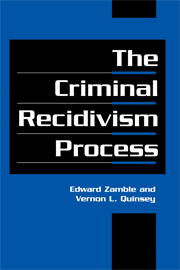Book contents
- Frontmatter
- Contents
- List of Illustrations and Tables
- Preface
- 1 Introduction: The Prediction of Criminal Behavior
- 2 The Study
- 3 Recidivists: A General Profile
- 4 Comparisons with Nonrecidivists
- 5 Comparisons across Offender Groups
- 6 Comparisons within Offender Groups
- 7 Final Considerations
- References
- Appendix: Interview Form
- Index
1 - Introduction: The Prediction of Criminal Behavior
Published online by Cambridge University Press: 02 February 2010
- Frontmatter
- Contents
- List of Illustrations and Tables
- Preface
- 1 Introduction: The Prediction of Criminal Behavior
- 2 The Study
- 3 Recidivists: A General Profile
- 4 Comparisons with Nonrecidivists
- 5 Comparisons across Offender Groups
- 6 Comparisons within Offender Groups
- 7 Final Considerations
- References
- Appendix: Interview Form
- Index
Summary
Static and Dynamic Variables
The prediction of both general and violent criminal recidivism of persons released from correctional institutions has received extensive study (for reviews see Andrews and Bonta, 1994; Blackburn, 1993). This literature indicates that a variety of measures are positively and reliably related to the probability of criminal recidivism. Enough work has been completed to establish a consensus within the correctional research community about the classes of variables that are valid predictors of recidivism, and the degree to which they are related to the criterion behaviors of interest.
Among the best commonly available predictors are youthfulness and number of previous arrests. Other predictors, including age at first arrest, criminal versatility (variety of offending), alcohol abuse, and low educational attainment, are usually found to be positively but less strongly related to recidivism rates. Although there are conflicting findings on the use of institutional behavior in predicting postrelease recidivism, escape and escape attempts have always been found to be related to higher recidivism rates. Measures of antisociality, such as psychopathy (Hare, 1991), yield higher correlations with recidivism than single predictors commonly available in institutional files, although they are more expensive to collect.
It is of interest that the types of predictors found useful in predicting recidivism among convicted offenders are very similar to those that have been found to predict the initiation of criminal behavior in longitudinal studies of relatively unselected samples of children and adolescents.
- Type
- Chapter
- Information
- The Criminal Recidivism Process , pp. 1 - 14Publisher: Cambridge University PressPrint publication year: 1997

